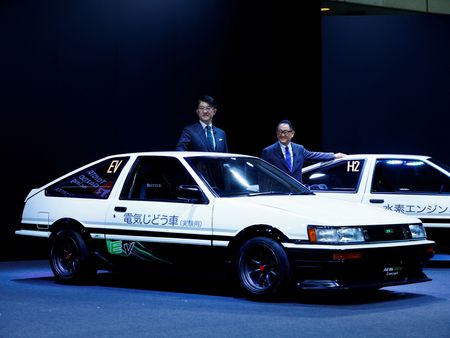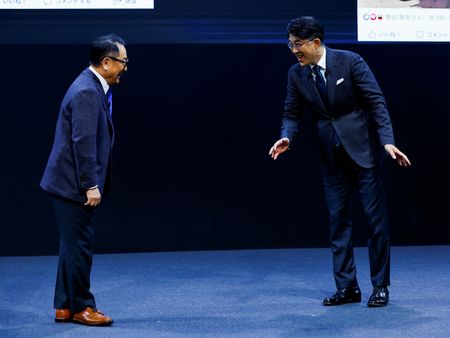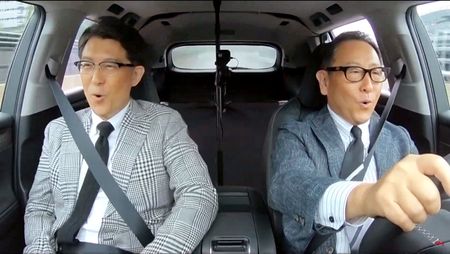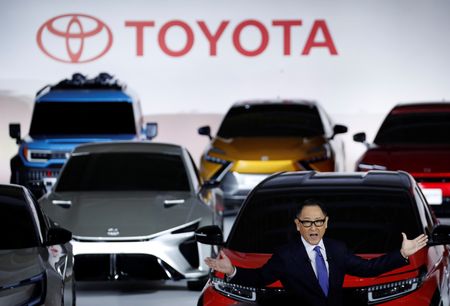By Makiko Yamazaki and Kevin Krolicki
TOKYO (Reuters) – Toyota’s chief executive will step down as head of the company his grandfather founded, the automaker said on Thursday, handing over to the leader of its Lexus luxury brand as the Japanese giant struggles to meet the shift to electric vehicles.
The 53-year-old chief branding officer and president of Toyota Motor Corp’s Lexus brand, Koji Sato, will take over from April 1 when Akio Toyoda becomes chairman, it said.
The issue of who would take over the top spot at Toyota – Japan’s biggest company and one of the world’s most influential manufacturers – has been an increasing focus for investors. But the timing of the announcement was a surprise.
Under the 66-year-old Toyoda, who led the company for more than a decade, the automaker has appeared reluctant to embrace electric vehicles, arguing the hybrid technology it pioneered with its once market-leading Prius was a better fit for many drivers.
It also touted hydrogen-powered cars as the future, raising fears it would be left behind by the rise of electric vehicles, as the flashier and more nimble Tesla Inc eclipsed it in both innovation and share price.
That insistence on hybrids and hydrogen also prompted criticism from investors and environmental activists who once widely praised Toyota’s technology and emissions record.
“No doubt Mr. Toyoda has been a competent CEO, but the whole auto sector needs to make disruptive change and Toyota has been lagging in this in our view, so this could be chance for a fresh start,” said Anders Schelde, chief investment officer of Danish pension fund AkademikerPension, which has repeatedly pressed Toyota to accelerate its shift to electric vehicles.
“We are hopeful this could help Toyota to set a new direction, but it remains to be seen.”
The succession announcement was broadcast on a webcast through the automaker’s Toyota Times channel in what looked more like a stilted talk show with a host rather than a formal corporate announcement.
“The timing of this was a surprise,” said Seiji Sugiura, an analyst at Tokai Tokyo Research Institute, who noted there may have been a “sense of stagnation” inside the company given recent pressure on the share price.
“Probably, the day-to-day management will not change. Having Akio Toyoda step away from being CEO may increase his symbolism within the company and it may be hard for the young, new president to really show his hand.”
There was also little mention of concrete corporate strategy or investment priorities to come. Toyoda said Sato’s mission would be to transform Toyota into a “mobility company,” without specifying what that would entail.
“The CEO needs youth, energy, strength,” Toyoda said, saying that he himself was now a “relic” of an older generation. In Sato, too, he said, he had chosen a fellow car aficionado.
‘BATON TOUCH’
Toyoda described the hand-off as a “baton touch” in leadership, but the staged event highlighted his continued central role. He turned from time to time to offer instruction and reminders to Sato.
Sato said Toyoda had offered him the CEO job at the end of the year when both were in Thailand for an event to celebrate Toyota’s 60th anniversary of operations there.
“I didn’t know how to respond,” Sato recalled. “I thought it was a joke.”
One Toyota executive, who asked not to be identified, said the automaker was headed for a period of “cloistered rule,” referring to the period in Japan’s history when a retired emperor continued to call the shots.
During his more than a decade at the top, Toyoda presided over the carmaker during a period of intense change in the industry and rising uncertainty about how legacy automakers can fend off the challenge from newer challengers such as Tesla.
Toyoda, speaking at a news conference, said his term at the helm of Toyota started in 2009 with “crisis after crisis” from the effects of a global recession, to Toyota’s recalls and safety crisis to the disruptions that followed the 2011 earthquake and tsunami in northern Japan.
At a shareholder meeting in June last year, Toyoda said he was “thinking about timing and the selection of a successor” when asked about his future.
On Thursday, he said Sato was chosen because he “worked hard” to learn Toyota’s philosophy.
Sato started his career at Toyota in 1992, before rising through the ranks to become chief engineer of Lexus International, a luxury auto brand of Toyota, in 2016, according to his profile on the company’s website.
He has held positions as the president of Lexus International and Gazoo Racing Company, Toyota’s motorsport brand, since 2020. He also took on an executive role at Toyota and became its chief branding officer in January 2021.
Philip Craven, a Toyota director, said in a recorded video statement that the board had reviewed and approved the succession plan put forward by Toyoda and the outgoing chairman, Takeshi Uchiyamada.
(Reporting by Makiko Yamazaki and Kevin Krolicki; Additional reporting by Tokyo bureau; Writing by David Dolan; Editing by Muralikumar Anantharaman and Kim Coghill)




